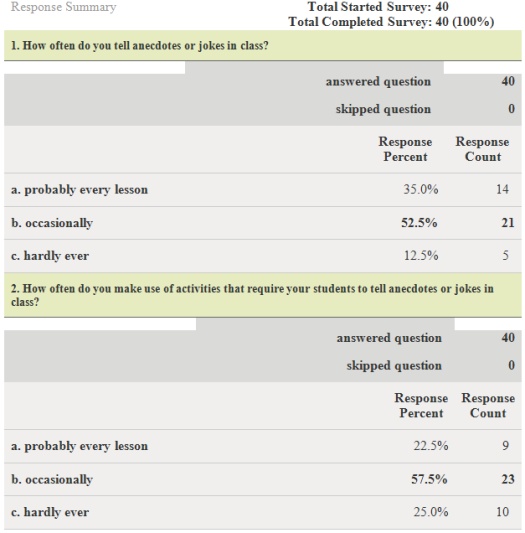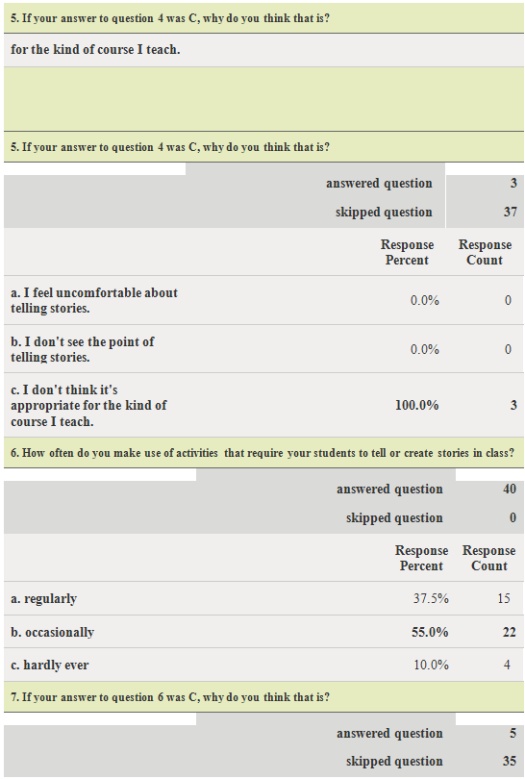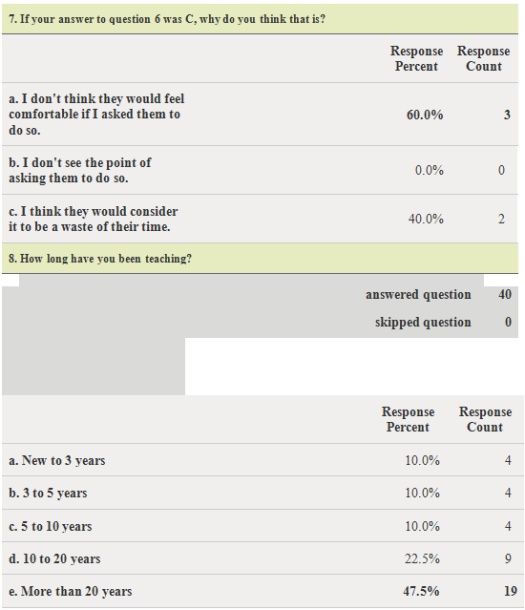Attitudes Towards Storytelling in ELT
Michael Berman, UK
Apparently, the praying mantis has only one ear, which is located between its legs. We, on the other hand, as Epictetus (c 55-135 AD) pointed out, have two ears and one mouth, which means that we can listen twice as much as we speak. Telling stories to our students can provide a means of ensuring that this is what our learners do. At the same time, however, we need to be able to differentiate between productive and non-productive TTT (teacher talking time) in order to make the process an effective one.
Below is a multiple choice questionnaire that I invited visitors to my website to complete anonymously on attitudes towards storytelling in English Language teaching, together with a summary of the responses received. It is followed by an analysis of the results that were obtained, and the conclusions that can be drawn from them.



The website www.Thestoryteller.org.uk has a wide spread of readers from all over the world and consequently teachers from various cultures and teaching contexts are likely to have taken part in this survey. The survey was also promoted on the Humanising Language Teaching Magazine website http://hltmag.co.uk/index.htm published by Pilgrims English Language Courses. Moreover, as the results to question 8 show, both teachers starting out and experiences practitioners have completed the questionnaire. With hindsight, it might have been useful to include extra questions to find out exactly what cultures and teaching contexts the participants represented. On the other hand, if the number of questions had been increased, it might have had an adverse effect as fewer people might have taken the time to complete the survey.
Telling stories is one of the basic ways that humans communicate with each other. When you tell your partner about your day at the office, you are telling a story. When you repeat a joke you have heard, you are in effect telling a story. It is something we do all the time without even being aware of the fact, which makes it highly probable that teachers do this in class a lot more than they realize, and the percentage of teachers who tell anecdotes or jokes in class every lesson could therefore well be even higher than the results indicate. Moreover, if we take student to student talking time into account, as well as student to teacher talking time, it is highly likely that our learners tell anecdotes or jokes in class more frequently than we are aware of too.
By choosing to tell rather than read stories, there are a number of advantages to be had, and the results would seem to indicate that most teachers are well aware of this. Speakers who rely on scripts are much more restricted when it comes to using non-verbal signals. This is because gestures look very unnatural when not co-oriented with talk that is spontaneous or “off the cuff”. If you can tell a story rather than read it, this leaves your hands free to gesture, allows you to make eye contact with your audience and to calibrate for their responses.
There are some, however, who may feel uncomfortable about telling rather than reading stories, and this is reflected in the responses too. It is a skill that improves with practice though, and the more people practise, the better they get. As for those who are afraid that they might not remember every word of the story exactly right, the truth is it makes no difference. For no two people ever tell any story the same way. A story is like a letter that comes to us from yesterday. Whoever tells it adds his or her words to the message and then sends it on tomorrow. Moreover, to listen to stories without ever telling one is like harvesting grain without sowing seeds; it is like picking fruit without pruning the trees.
The Hasidic Jews used storytelling in introducing their rituals and beliefs to young children, and in the New Testament Jesus Christ used the parable form in his teachings. Even today, storytelling remains a part of Christian services, especially for young children and for use in Sunday Schools. In fact, all the major religious traditions have made use of metaphorical stories to communicate their teachings - the stories from early India, Greek fables, Zen, Sufi, and Hasidic tales - as they have long been recognised as a means of bypassing the set attitudes and limitations of the conscious mind. Stories not only entertain; they can also alter our experience so as to facilitate growth and change.
Why tell stories in the classroom? Because storytelling engages the imagination, promotes language development, encourages reading, teaches people about other cultures, and helps them to understand both themselves and others. And storytelling in the classroom is merely an extension of what we already do on a daily basis.
A story is, in a sense, a journey, as when you make a start on it, you do not necessarily know where you will be going, what will happen there, or who you are going to meet along the way. That explains our fascination with the form, and why, however many stories we hear or are told, we always want more and can never get enough of them. As to why we choose to go on journeys, it could be to confirm or disprove our expectations about a place, or to find out something new about ourselves. And it is for these reasons we read stories too.
The main conclusion that can be drawn from this research is that storytelling takes place in the classroom to a greater extent than most teachers realize, that both inexperienced and experienced teachers make use of it, and there are good reasons as to why this should be the case. However, as with any activity, there is a danger of overkill unless a variety of pre-, while, and post storytelling activities are employed by teachers to maintain the learners’ interest and involvement in the process.
Although input sessions on teaching the four skills – listening, speaking, reading, and writing – are included on all initial training courses, storytelling is probably only mentioned in passing and perhaps not even then. Given how much time we all spend on the practice though, in both our professional and personal lives, there is surely a strong case to be made for redressing this imbalance – if not on initial training courses, then at least when it comes to providing teachers with further professional development. After all, it could well be the case that the respondents who indicated that they did not think their learners would feel comfortable if asked to listen to or tell stories or that they would consider it to be a waste of their time, did so precisely because they have had little or no training in how to use storytelling effectively or in how to present it to learners in a positive light.
A number of training institutions already provide the YL Extension to the basic CELTA course, which is primarily aimed at teachers who have gained the Cambridge/RSA CELTA, CTEFLA or Prep. Certificate and who wish to take an 'extension course' in teaching young learners. Successful candidates receive an endorsement to their Certificate. And the results of this survey indicate there is a strong case to be made for adding another extension course to the CELTA - in making use of storytelling in the Language Teaching Classroom.

Please check the Creative Methodology for the Classroom course at Pilgrims website.
Please check the Methodology and Language for Primary Teachers course at Pilgrims website.
Please check the Methodology and Language for Secondary Teachers course at Pilgrims website.


|